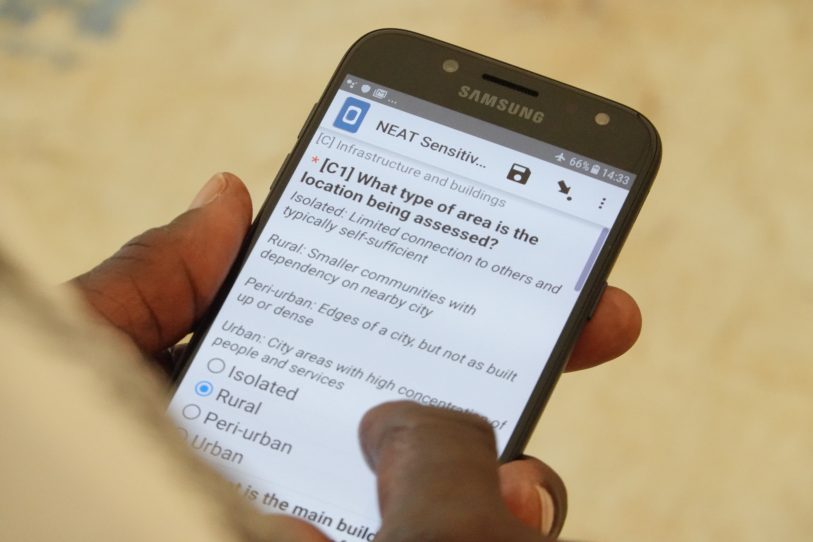Download the tool in English here.
Téléchargez l’outil en français ici.
Descargue la herramienta en español aquí.
Updated November 2021 (updated file names).
Overview
The Nexus Environmental Assessment Tool (NEAT+) is a rapid and simple project-level environmental screening tool developed by the UNEP/OCHA Joint Environment Unit, USAID, UNHCR, NRC, IUCN, WWF and other partners that allows humanitarian actors to quickly identify issues of environmental concern before designing longer-term emergency or recovery interventions.
Data is gathered on the KoBo platform (on phone, tablet or computer) and produces an automatically generated report in Excel, providing organizations with a snapshot of environmental vulnerabilities in their operations and highlighting environmental risks associated with specific humanitarian activities.
The NEAT+ was specifically designed to address the needs of humanitarian actors and to provide a creative and practical approach to integrating more sustainable environmental practices into humanitarian aid. The tool is freely available to all in English, French and Spanish to use and can be adapted to organizations’ individual needs.
About the NEAT+ tool

NEAT+ combines information on available environmental sensitivities with site-specific data, allowing project managers to understand environmental sensitivities and implement mitigation measures.
NEAT+ is conducted on the KoBo Toolbox data collection platform – an open source data collection tool – (on phone, tablet or computer) and produces an automatically generated report in Microsoft Excel, categorizing areas of risk into low, medium and high level of concern. The tool assesses the current sensitivity of the crisis-affected environment, highlighting any underlying risks and vulnerabilities to the environment and affected communities. The NEAT+ also identifies potential activity related environmental risks posed by humanitarian relief and recovery projects. A set of mitigation measures and suggestions for further resources and tools available allows users to effectively prioritize areas of concern.
As an initial rapid screening tool, the NEAT+ helps humanitarian actors determine whether a more comprehensive environmental assessment should be carried out. It is a highly flexible tool that can be used by anyone who wishes to manage environmental projects and requires an initial assessment of their specific situation.
The NEAT+ was developed by the Coordination of Assessments for Environment in Humanitarian Action Joint Initiative; a multi-stakeholder project aiming to improve the coordination between environmental and humanitarian actors.
Click the following links to watch the promo video on applying the NEAT+ in humanitarian settings in English, French and Spanish.
To find out more about how to apply the NEAT+, please refer to the guidance toolkit which provides a thorough step-by-step guidance on how to use the tool or watch our NEAT+ “how to” video here.
A Microsoft PowerBI Dashboard is available for the NEAT+. It is offered as a base for organizations that wish to use it and can be used as is or tailored towards an organization’s specific needs and modified accordingly (e.g., by changing logos or title, reorganizing visuals, adding or deleting sections, etc.). To access the dashboard template, please contact the JEU at ochaunep@un.org.
Examples of NEAT+ field application by humanitarian organizations
NEAT+ has been successfully pilot tested and applied by over ten humanitarian organizations in around 20 field operations worldwide. See examples and links to the findings of previous NEAT+ environmental scoping missions below:
- NEAT+ pilot test with the UN Refugee Agency (UNHCR) and the JEU in the Mantapala refugee settlement, Zambia, on the border with the Democratic Republic of Congo. The pilot test identified and synthesized multiple risks facing the settlement including those relating to specific food security, shelter and WASH activities. Consult how the NEAT+ piloting process unfolded in Zambia here or read more about it here.
- NEAT+ Environmental scoping mission in the Bidibidi refugee settlement, located in the West Nile Area of Uganda, conducted by the UN Environment Programme/OCHA Joint Environment Unit (JEU) and Norwegian Refugee Council (NRC). The purpose of the mission was to highlight key areas of environmental risk in the NRC West Nile programme while using, testing and promoting the NEAT+. Learn more about the key findings of the environmental scoping mission here or download the full mission report here.
- NEAT+ environmental scoping mission to Myanmar by the JEU and NRC, highlighting key areas of environmental risk in Hpa An Township, Kayin State, consult the findings of the scoping mission here or read the full report here.
- NEAT+ environmental scoping mission to the UNHCR reception center, Centro de Atención Integral (CAI) in Maicao, northeastern Colombia, undertaken by the JEU and UNHCR. The purpose of the mission was to highlight key areas of environmental risk in UNHCR’s programming in the CAI and neighbouring host community and to evaluate the effectiveness of the NEAT+ tool in a reception camp setting. More information about the key findings can be found here. The full mission report is available here.
NEAT+ Process Guidance
The NEAT+ process guidance provides an outline of environmental management within humanitarian organizations, including an explanation of available assessment tools, and explains how the NEAT+ fits into overall environmental management systems within humanitarian organizations. It further illustrates how the NEAT+ can be used in field operations and integrated into the Humanitarian Programme Cycle (HPC).
You can consult the process guidance here.
Feedback
Share your feedback with us: To continuously improve the NEAT+ and adapt it to user’s needs, we would like to learn more about your experience as a user and the context in which you used the tool in. Take 10 minutes to fill out this NEAT+ user feedback form. All responses are confidential and anonymous.
If you have any further questions, comment or feedback, please contact the JEU (ochaunep@un.org).
Factsheets
Consult the NEAT+ factsheet, which is available in English, Spanish or French.




